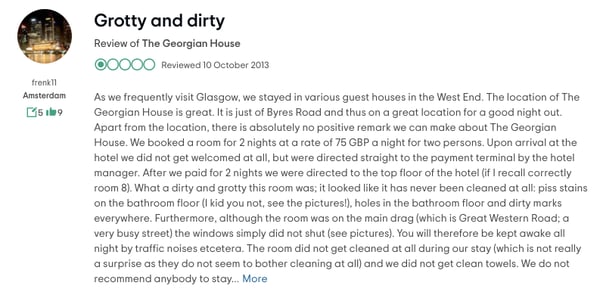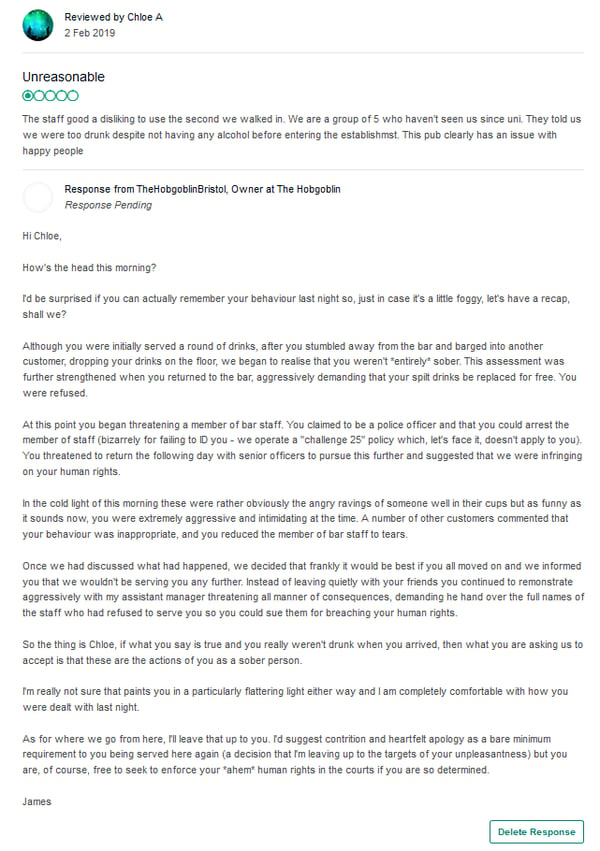How to respond to negative feedback
Receiving negative feedback can be quite an emotional experience, especially when you’ve invested yourself in the experience your customers receive. It can often feel like a personal attack and you can feel robbed of the opportunity to protect your reputation when that negative feedback is shared online for the world to see.
From the initial surprise, the mind can steadily turn to feelings of hurt, anger, sadness and outrage. Yet keeping these feelings in check can be key to not inflaming the situation and turning a detractor into a raving fan of your business.
Obviously, not everyone can be won over, some people are just impossible to please and you shouldn’t see it as a failure if you can’t please everyone. All you can do is give a good account of yourself and show others reading the review that you do care about people’s experiences, and that you’ll go the extra mile to fix any issues someone has with you.
Having helped many businesses respond to feedback and public comments that range from the questionable to the abusive, the team at Review Tui thought we’d share our tips on managing and responding to negative reviews online.
Always reply to negative reviews
And positive ones for that matter. Engaging with the feedback shows that you value it, and negative feedback is arguably more valuable than praise as you can use it to improve and give even more people an exceptional experience. A passive acknowledgement of their feedback, and the value it holds, is always a great first line when responding to any negative feedback. Something along the lines of:
“Thank you for taking the time to share your experience with us, we really value your comments.”
The above acknowledges the individual and provides context for you addressing their feedback directly. Variations on this are very easy too, so you don’t sound like a robot by copying and pasting the same response. It’s very important to seem human, while maintaining high levels of professionalism.
Show humanity
It can be very easy to come across as incredibly robotic when replying to negative comments, especially when they’re slightly scripted. Therefore it’s important to inject a piece that reflects that the negative comments are about a business that cares or people who strive to do their best. The following is often good to add to help diffuse the situation slightly:
“As a small family-run business we strive to give everyone the best experience possible and we’re sorry to hear that we didn’t meet your expectations on this front.”
It’s important to not necessarily accept blame for anything here but instead, address the fact that they have a set of expectations or standards and, no matter how unrealistic or unreasonable those standards may be, you haven’t met them and you can safely acknowledge that. If they haven’t specifically outlined an area you fell short and have instead simply said you’re rubbish you could alternatively use the following sort of language:
“As a small business, we’re always looking to hear from customers and learn where we can improve. Knowing you had a poor experience will help us reflect on ways we can improve.”
Addressing the issues
It’s better to take the conversation offline as early as possible. You don’t want to get into a ‘he said, she said’ debate on the internet. You can go back with a dozen reasons as to why the comments are valid or invalid but that can come across as combative and may cause people to rally around the reviewer and make your life a lot harder! You can encourage a continued dialogue, without inflaming the situation by suggesting they contact you to resolve the situation.
“We’re keen to understand the situation that led to your review in more detail, and put things right. Would you mind contacting us on [insert phone number] and asking for [person handling issue] so we can discuss this in more detail?”
It can be nerve-wracking to be the person a disgruntled customer might call and speak to but it’s important to show that the negative experience is being taken seriously. It also shows any future customers that you take people’s experiences seriously and that they could expect the same personal touch if they were to have a negative experience. For larger companies directing them to customer service could be good, but a little impersonal.
How to handle a disgruntled customer directly
Regardless of whether it’s over the phone, over email or in-person handling someone that’s angry, agitated or unreasonable is a challenge. Even a reasonable person who raises their hand and says their experience wasn’t good enough can need some delicate handling. There are dozens of guides for conflict resolution but the key things to keep in mind are the same regardless of the situation. They include:
- Understanding the source of the situation - what, specifically, was the reason behind the customer’s current state.
- “Would you mind explaining, in as much detail as possible how we let you down today?”
- Acknowledge and observe - ensure the complainant feels heard and that you’re listening. Ask if there’s anything else they’d like to mention or if that’s the whole issue.
- “Thank you for that insight. Is there anything else you’d like to take this opportunity to mention?”
- Ask for insight - is there anything you could have done differently to have avoided the situation?
- “In your view what measures could we have taken to have avoided this situation from occurring in the first place?”
- Ask for outcomes - how do they envisage the situation being put right?
- “Is there anything we can do to put this right?”
With the last point, it’s worth knowing what’s within your power to offer. It can also be good to plant the seed of acceptable solutions in their mind by ending that sentence with a few suggestions. “Could we offer you a discount on your next visit?”, “Could we give you the desserts for free?”. It’s important that the person handling the issue has the authority to offer come compensation so should be the person assigned to handle the issue when it arises. It’s better to do this sooner rather than later as the situation could be made worse if the complainant has to explain their frustrations twice.
Examples of how to not respond to negative reviews
And if you’re still worried that you might make a mistake and mismanage your public response take comfort in that you’re probably not going to do as badly as these business owners:


And this lengthy "tome" sourced from BoredPanda.

And every so often, when you’re definitely in the right and the customer’s review is not only unreasonable but inaccurate, it might be OK to call them out about it. Like this pub in the UK did with one drunken reviewer.

If you’re looking to get more public reviews so that the right types of customers come to your business then try our platform today.




